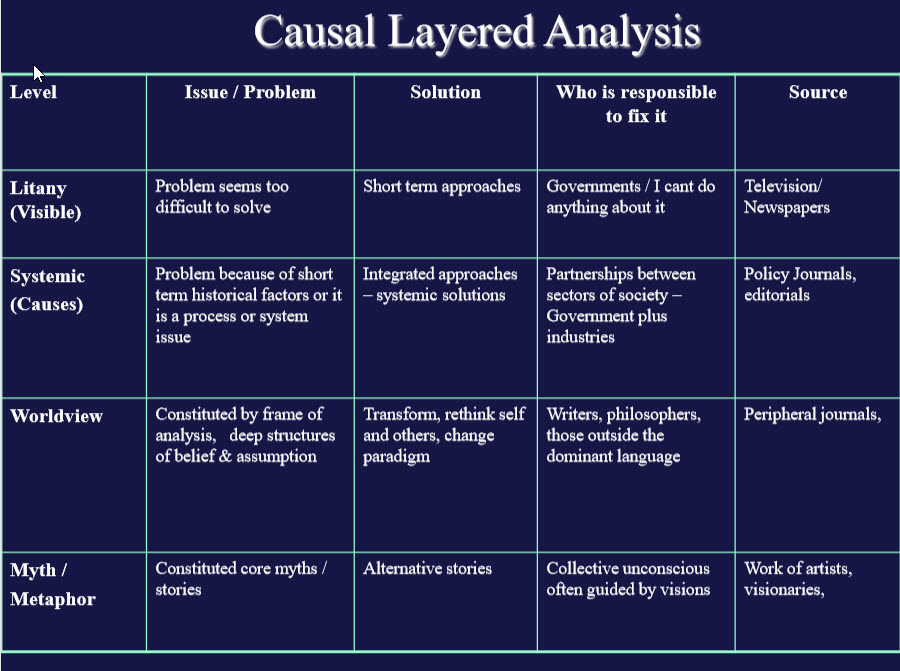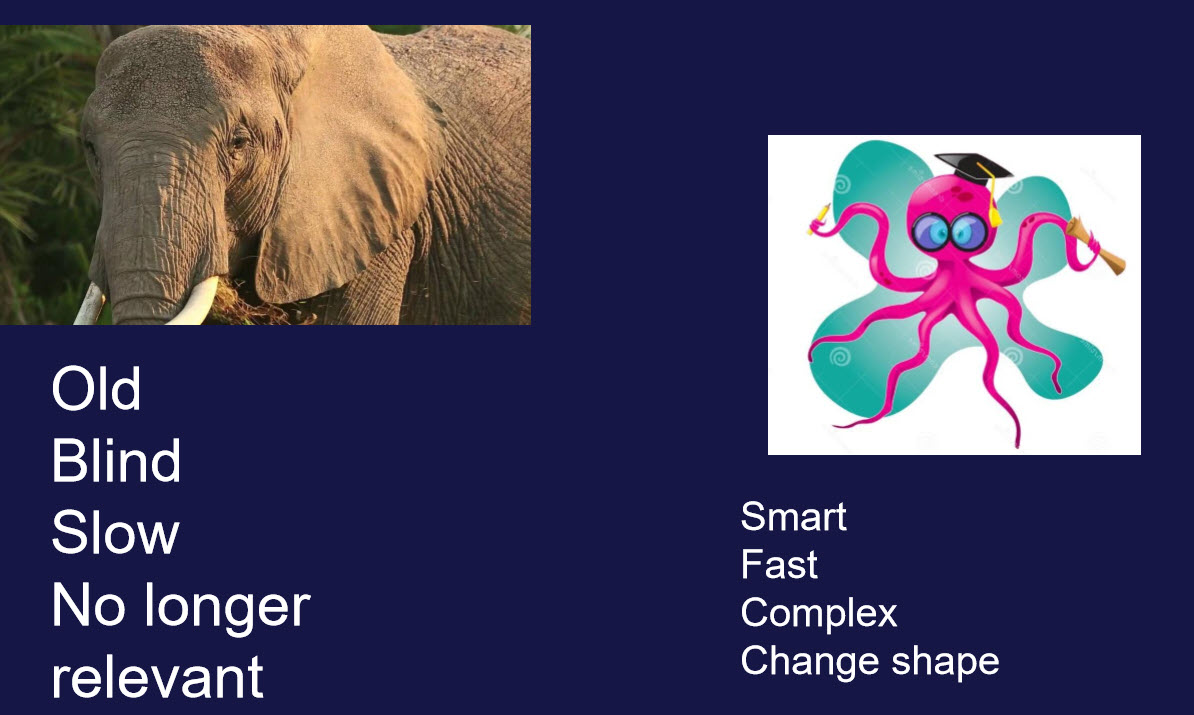Causal Layered Analysis, or CLA for short, identifies four levels of causality. The litany of the superficial and ofter official description of reality - the problem as it is. The deeper systemic or diverse drivers and socio-political and economic factors. And the still deeper varied worldviews that inform systemic causation. Finally, are the deeper metaphors and myths that inform the entire process. CLA, however, does not conclude with the mere causation. It seeks to create new futures by creating new narratives and systems that support these stories and new measurements that ensure the stories are grounded in empirical reality. CLA can be applied for the external world or the inner world ie the CLA of the selves.
.gif)
For organizations, CLA allows the perspectives of a range of staff and stakeholder groups about an issue or strategic option to be explored to identify driving forces and worldviews shaping that issue. It is particularly useful when different groups hold different perspectives on the future of an organization and what strategy should be actioned.

Through group discussion, sharing of diverse perspectives, and surfacing contrasting worldviews and underpinning myths, the method encourages the deconstructing of conventional thinking to produce a shared view of possible future outcomes that can break existing paradigms of thinking and operating.

Uses of the method
- Question conventional future thinking
- Uncover why things are not working today and develop potential and shared solutions
- Explore issues from qualitative perspectives to strengthen understanding of the issue
- Develop a shared organizational strategy
- Facilitate multi-cultural dialog and understanding
- Gain a better understanding of one's own worldview and ways of making sense of the world
- Develop different sorts of products and services and revised policies
Benefits
- Collaborative and appealing to a wide range of participants
- Integrative with other foresight methods
- Supports the development of powerful and richer future scenarios
- Useful check that constructed scenarios are robust across diverse perspectives
- Develops shared visions of a preferred organizational future
- Potential for issue transformation
- Links short, medium and long-term strategic thinking
- Ensures actions emerge from depth, instead of a checklist of things to do
Disadvantages
- Needs a clearly expressed question to be prepared
- Requires participants to be willing to share their perspectives and challenge their assumptions about how the organization operates
- Requires acceptance of the basic CLA theory by the participants
- May constrain action through 'analysis/paralysis'
- May reduce individual creativity
- Needs time and requires undertstanding of depth and patience
- Requires experienced facilitator
Steps to complete
Begin by:
- Using a metaphor to describe the subject, person, organization, industry or country under scrutiny e.g We/They are a 'Slow Elephant'! Find a suitable image of your metaphor and add to the project form with your metaphor title.

- Identifying the critical issues or trends that are contentious or critical to better understand
Then apply the CLA method:
Brainstorm participants ideas on:
- Litany: map current responses and views about the issue - at this level, people are describing their reaction to the issue as they 'feel' it
- System causes: identify what is causing the issue to develop - this level identifies the trends and drivers shaping the issue as it appears to participants - these drivers are usually accepted and not questioned at this level
- Discourse/worldview: ask whose worldview is shaping the issue, whose voice is being heard and whose is not,
- Myth/metaphor: identify stories and myths that underpin the dominant and minority worldviews to demonstrate the depth of thinking that is generating the issues we see today.
looking at each criterion in turn.
- Then conduct a group discussion about the exercise making sure you capture the myths and metaphors that arise.
- The next stage is to re-build that thinking by exploring a new metaphor that can inform thinking and start to shape the issue in a shared way.
- Now take one of the myths or metaphors and reverse the order of the criteria working up the list in a second round of brainstorming sessions to finally create a new litany of happenings and a potentially new alternative future.
- Agree the best metaphor for your desired future and find a suitable image of your new metaphor and change the project form with your new metaphor title.
- Capture your most exciting idea and biggest fear
- Capture unique insight into new ways of seeing that can be utilized by the organization.
- What conclusions can we draw from the exercise(s)?
- How might the future be different?
- What certainties/uncertainties are implied in the conclusions?
- How does A affect B?
- What is likely to remain the same or change significantly?
- What are the likely outcomes?
- What and who will likely shape our future?
- Where could we be most affected by the change?
- What might we do about it?
- What don't we know that we need to know?
- What should we do now, today?
- Why do we care?
- When should we aim to meet on this?
- Develop next steps and determine if any further research required
Example
Using Futures Studies Methodologies to Explore the Economic Participation of the Older Cohorts of South Africa’s Population Towards 2030
Collaboration
'CLA' can be shared with others or kept private using the 'Visible to' fields and through the 'tag', 'report', 'share'', 'link and 'comment' functionality. Use 'tag' and/or 'report' to aggregate your analyzes, 'share' with others via email, Facebook, and Twitter etc. or add a 'comment' to ask others where they agree/disagree and encourage them to make their own analysis from their unique vantage point.
Lead Facilitator
This tool is best used with a trained consultant in attendance first time out and maybe beyond.
We recommend the person who invented this brilliant method to help you find the right facilitator as follows:

Sohail Inayatullah
Further reference
- Causal Layered Analysis: A Four-level Approach to Alternative Futures - Sohail Inayatullah, April 2017
- CAUSAL LAYERED ANALYSIS MASTER CLASS - Sohail Inayatullah
- Future Research Methodology - Version 3.0, Millennium Project 2009. CD ROM
- The Causal Layered Analysis (CLA) Reader, Sohail Inayatullah (editor), 2004
- TEDxNoosa 2013, Sohail Inayatullah, Causal layered analysis
- Causal Layered Analysis, Foresight, Horizon Scanning Centre
- Using Causal Layered Analysis to Explore the Relationship Between Academics and
- Administrators in Universities: Maree Conway, Thinking Futures, 2012
- CLA as Process: Mapping the Theory and
- Practice of the Multiple: Marcus Bussey, June 2014
Contact us
Even with all the advice and tools we have provided here starting a foresight project from scratch can be a daunting prospect to a beginner. Let us know if you need help with this method or want a group facilitation exercise or full project or program carrying out by us. We promise to leave behind more internal knowledgeable people who can expand your initiative for better organizational performance. Contact us today for a free discussion on your needs. Are there other enhancements or new methods you would like to see here? Let us know and we will do our best to respond with a solution quickly.
Copyright
Some rights reserved. This particular part of the website is licensed under a Creative Commons License.
.gif)



